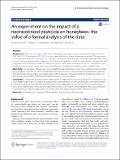An experiment of the impact of a neonicotinoid pesticide on honeybees : the value of a formal analysis of the data
Abstract
Background: We assess the analysis of the data resulting from a field experiment conducted by Pilling et al. (2013) on the potential effects of thiamethoxam on honey bees. The experiment had low levels of replication, so Pilling et al. concluded that formal statistical analysis would be misleading. This would be true if such an analysis merely comprised tests of statistical significance and if the investigators concluded that lack of significance meant little or no effect. However, an analysis that includes estimation of the size of any effects—with confidence limits—allows one to reach conclusions that are not misleading and that produce useful insights. Main Body: For the data of Pilling et al. we use straightforward statistical analysis to show that the confidence limits are generally so wide that any effects of thiamethoxam could have been large without being statistically significant. Instead of formal analysis, Pilling et al. simply inspected the data and concluded that they provided no evidence of detrimental effects and from this that thiamethoxam poses a “low risk” to bees. Conclusions: Conclusions derived from inspection of the data were not just misleading in this case but are unacceptable in principle, for if data are inadequate for a formal analysis (or only good enough to provide estimates with wide confidence intervals) then they are bound to be inadequate as a basis for reaching any sound conclusions. Given that the data in this case are largely uninformative with respect to the treatment effect, any conclusions reached from such informal approaches can do little more than reflect the prior beliefs of those involved.
Citation
Schick , R S , Greenwood , J J D & Buckland , S T 2017 , ' An experiment of the impact of a neonicotinoid pesticide on honeybees : the value of a formal analysis of the data ' , Environmental Sciences Europe , vol. 29 , 4 . https://doi.org/10.1186/s12302-016-0103-8
Publication
Environmental Sciences Europe
Status
Peer reviewed
ISSN
2190-4715Type
Journal article
Description
This work received funding from the MASTS pooling initiative (The Marine Alliance for Science and Technology for Scotland) and their support is gratefully acknowledged. MASTS is funded by the Scottish Funding Council (Grant reference HR09011) and contributing institutions.Collections
Items in the St Andrews Research Repository are protected by copyright, with all rights reserved, unless otherwise indicated.

